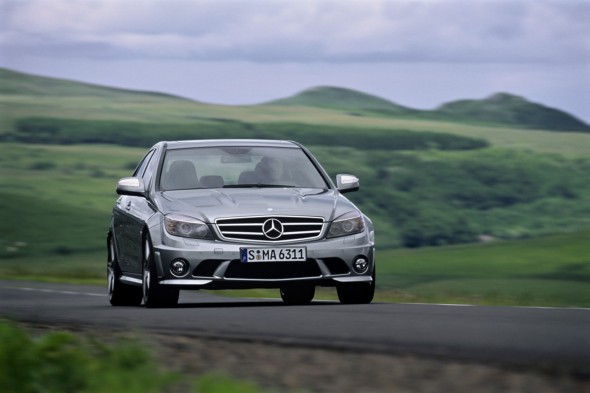Mercedes W204 C-Class 2007 –
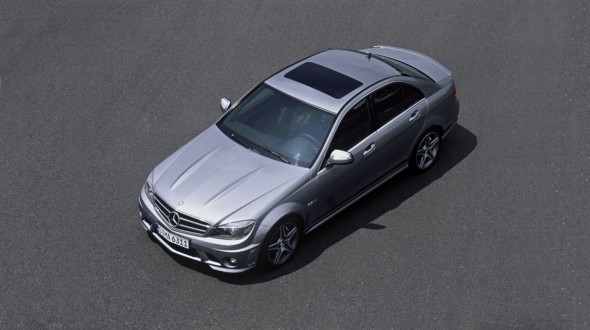
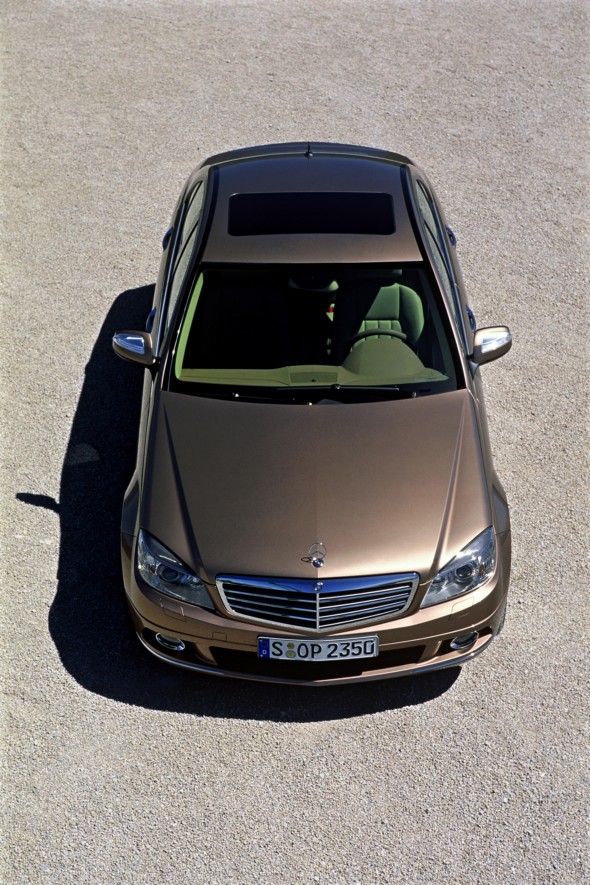
The new Mercedes-Benz C-Class: Superior safety, comfort and agility
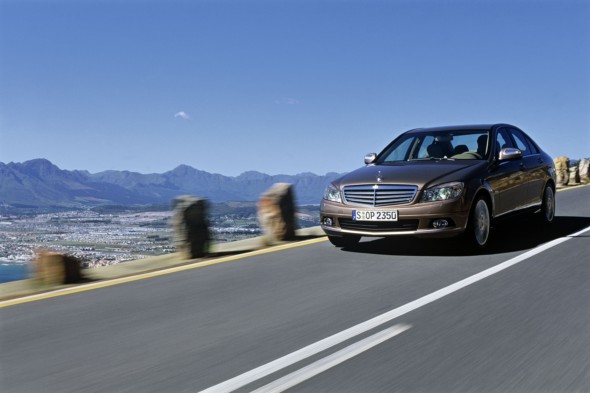
Stuttgart — Safety, comfort, agility: these are the outstanding attributes of the new C-Class. The Saloon excels with a many-faceted product concept which meets the expectations of various customer target groups. With the
AVANTGARDE, ELEGANCE and CLASSIC lines, Mercedes-Benz offers three individual models whose emphasis is on either comfort or agility. All model variants share the latest, state-of-the-art technology. This includes the newly developed AGILITY CONTROL package with situation-responsive shock absorber control, the Intelligent Light System with five different lighting functions and the PRE-SAFE® preventive occupant protection system.
There is a choice of four and six-cylinder engines with up to 13 percent more output than the preceding model, accompanied by up an to six percent lower fuel consumption.
With a length of 4581 millimetres, the Saloon is 55 millimetres longer than its predecessor. The body width has increased by 42 mm to 1770 millimetres, and the wheelbase by 45 mm to 2760 millimetres. These dimensions create the conditions for a generously sized interior, and therefore more comfort.
The front shoulder room has increased by 40 millimetres, for example. The design of the new C-Class is based on the modern Mercedes idiom, which reflects the technical superiority of automobiles bearing the star with taut lines and large, tranquil surfaces.
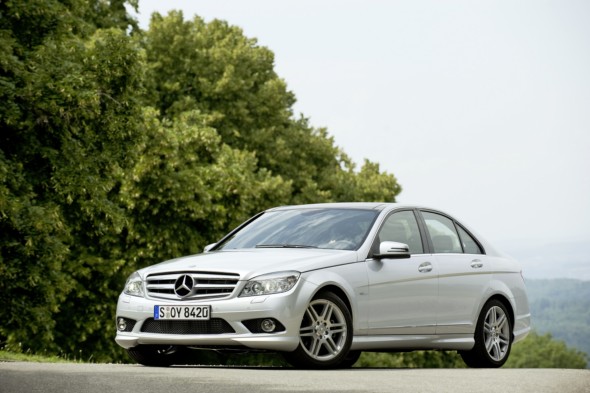
The pronounced wedge-shape of the front end serves to emphasise attributes such as agility and performance. For the first time in a Mercedes salon, the radiator grille is used as a distinguishing feature to position the model variants more clearly.
Three extended, horizontal louvres and a big centrally positioned Mercedes star characterise the AVANTGARDE model as a traditional design feature of sporty Mercedes models. Together with the sporty, high-quality appointments, this feature emphasises the youthful, agile appearance of this C-Class.
This sporty presence can be enhanced even further with the AMG sports package, which includes striking front and rear aprons plus side skirts.
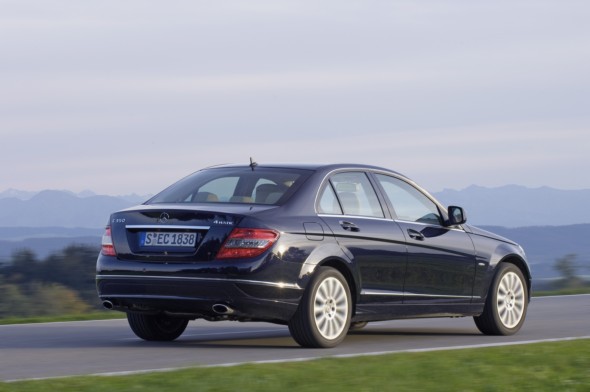
In the ELEGANCE model Mercedes-Benz employs a three-dimensional, louvred radiator grille with a high-gloss paint finish to accentuate other brand-typical attributes such as comfort and luxury. The CLASSIC model in the new C-Class is intentionally more restrained and traditional, but offers the same technical innovations as the other two model variants.
This “product-in-product” concept enables Mercedes customers to accentuate individual choices, and configure the C-Class to suit their personal taste and lifestyle even more emphatically than before. All the models offer the same, extraordinary driving experience that the Saloon provides by virtue of further technical improvements. Both by its outstanding long-distance comfort and its dynamic handling, the C-Class sets new standards in this market segment.
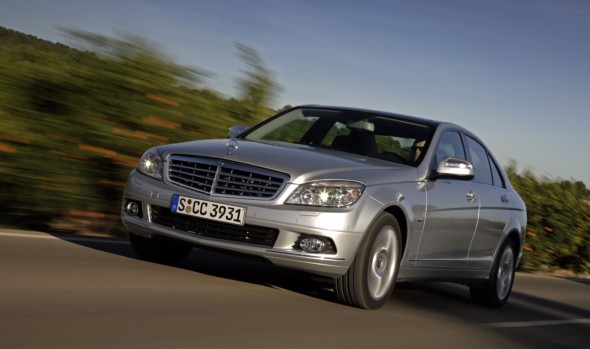
Shock absorbers automatically adapt to the driving situation AGILITY CONTROL – this is the term used by Mercedes-Benz for all new and further developments that improve both comfort and agility in equal measure.
This standard package includes the AGILITY CONTROL suspension, which controls the shock absorber forces according to the driving situation: when driving normally with low shock absorber impulses, the damping forces are automatically reduced for a noticeable improvement in ride comfort – but without any compromise in handling safety.
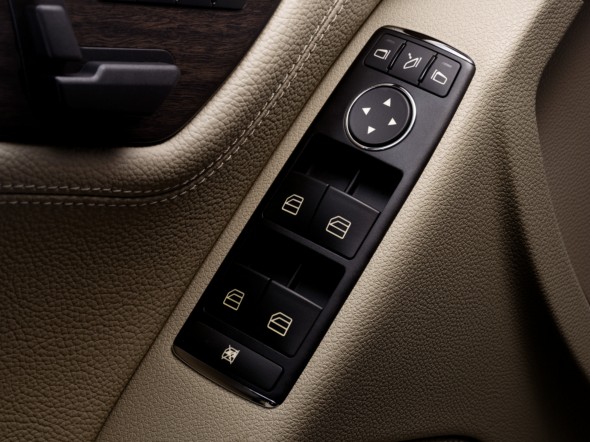
When driving more dynamically, the maximum damping forces are set and the car is effectively stabilised.
The AGILITY CONTROL steering of the new C-Class has a ratio of 14.5, and is therefore six percent more direct than the steering of the preceding model. The likewise included AGILITY CONTROL gearshift reflects the sporty character of the C-Class with a short travel and precise shifts.
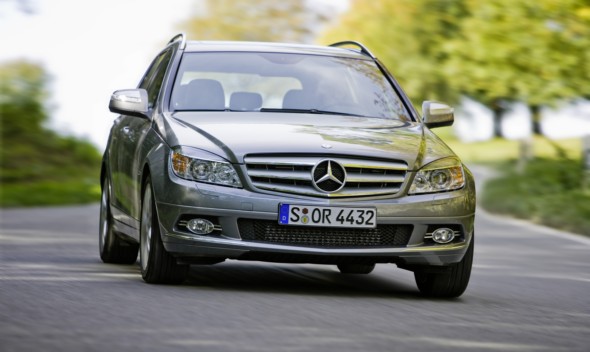
Mercedes-Benz has also developed the ADVANCED AGILITY package with a sporty driving mode, which will become optionally available from autumn 2007. This offers the driver a choice of two gearshift programmes: Sport and Comfort. Within these programmes the shock absorber for each wheel has infinitely variable electronic control.
A newly developed speed-sensitive steering with a more direct ratio, variable centring and adaptation of the accelerator characteristics and automatic transmission shift points is also included in the package.
ADAPTIVE BRAKE is another new development in the area of running gear technology. This is based on the technology of the S-Class and provides additional support functions for even more safety and comfort. Examples include Start-Off Assist for uphill gradients, priming the braking system in critical situations and light contact to dry the brake discs in wet conditions.
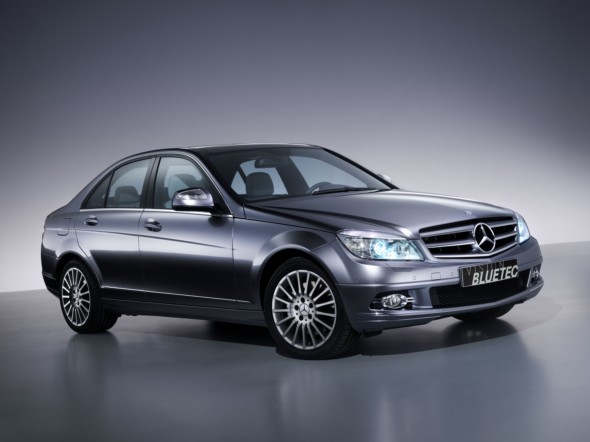
Output of the supercharged four-cylinder engines increased by up to 13 percent With a remarkable boost in output by up to 13 percent and an increase of around 18 percent in torque, the engines also do more than their bit to create the lively nature of the new C-Class. The four and six-cylinder units not only excel with powerful responsiveness, but also contribute to the excellent ride comfort of the Saloon with their improved smoothness.
Mercedes-Benz has paid particular attention to further development of the four-cylinder engines. In the petrol range, the output of the entry-level C 180 KOMPRESSOR has increased from the previous 105 kW/143 hp to 115 kW/156 hp, with maximum torque improved by 4.5 percent from 220 to 230 newton metres, while the C 200 KOMPRESSOR develops 15 kW/20 hp more than before. It has an output of 135 kW/184 hp and generates its maximum torque of 250 newton metres from 2800 rpm.

These modified engines considerably improve the performance and fuel consumption of the four-cylinder models. When accelerating from standstill to 100 km/h, the C 200 KOMPRESSOR is 0.5 seconds faster than its predecessor. Improvements in fuel consumption are equally impressive: the C 180 KOMPRESSOR consumes 0.3 litres per 100 kilometres less than before, while the combined fuel consumption of the C 200 KOMPRESSOR has been reduced by 0.5 litres per 100 kilometres.
Fuel consumption of the four-cylinder CDI engines reduced by 0.3 litres Further development of the four-cylinder units was also the main focus for the diesel engines. The engineers in Stuttgart have made further improvements to the engine, turbocharger and common-rail direct injection, modifying more than 90 components. As a result of these measures the new C 200 CDI has eleven percent more output than the preceding model, with 100 kW/136 hp versus the previous 90 kW/122 hp.
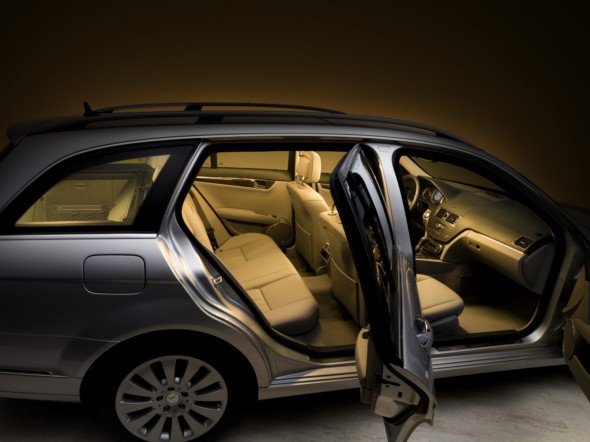
The C 220 CDI develops a peak output of 125 kW/170 hp (previously 110 kW/150 hp), and generates a torque of 400 newton metres from 2000 rpm — around 18 percent more than before. Fuel consumption has been reduced by up to 0.3 litres per 100 kilometres: in the New European Driving Cycle (NEDC), the C 200 CDI and C 220 CDI are able to travel 100 kilometres on just 6.1 litres of fuel.
The modern V6-engines in the C-Class range remain unchanged, with a choice of three petrol units developing 150 kW/204 hp, 170 kW/231 hp and 200 kW/272 hp. The six-cylinder of the new C 320 CDI has an output of 165 kW/224 hp.
With the exception of the C 350, all models in the new C-Class are equipped with a sixspeed transmission featuring AGILITY CONTROL gearshift as standard. The topof-the-range C 350 has 7G-TRONIC, the world’s only seven-speed automatic transmission, as standard equipment. This is also available for the other sixcylinder C-Class models on request.
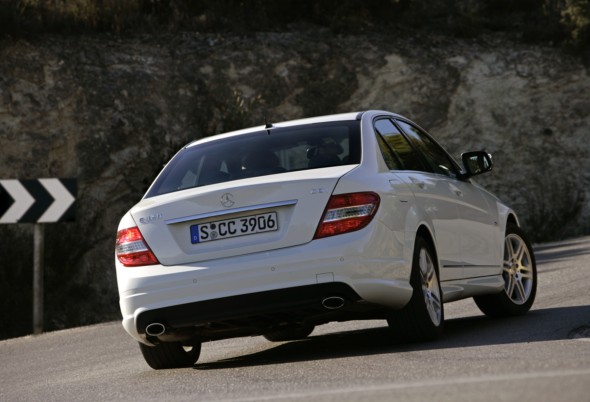
The latest Mercedes inventions ensure maximum safety During the course of its development, the new C-Class successfully passed more than 100 crash tests, including the particularly demanding, in-house impact tests of which some go well beyond the legal requirements.
Passing these is a precondition for the highest accolade in automobile safety: the Mercedes star. Occupant protection is based on an intelligently designed bodyshell, 70 percent of which consists of high-strength and ultra high-strength steel.
Compared to the previous series, Mercedes-Benz has enlarged the deformation zones even further and improved energy flows. The front-end structure of the new C-Class has four independently acting impact levels, which enable forces to be distributed over a wide area while bypassing the passenger cell.
The safety technology in the interior has been complemented with the very latest protection systems. Seven airbags are included as standard equipment: two adaptive airbags for the driver and front passenger, a kneebag for the driver, two sidebags in the front seat backrests and two large windowbags which extend from the A to the C-pillar during a side impact.
The driver, front passenger and the passengers on the outer rear seats also benefit from belt tensioners and belt force limiters as standard. The standard head restraints operate on the NECK PRO principle: during a rear-end collision the padded surfaces are pushed forward within milliseconds to support the heads of the driver and front passenger at an early stage. This significantly reduces the risk of a whiplash injury.

Mercedes-Benz has developed flashing brake lights as a major help in reducing rear-end collisions, and these are also standard equipment in the new C-Class. If the driver needs to brake hard at speeds in excess of 50 km/h, the brake lights flash rapidly to warn drivers following behind.
PRE-SAFE® is another special feature of the new Mercedes Saloon. This preventive occupant protection system (optional) is linked to active safety systems such as ESP® and Brake Assist, and is able to recognise critical driving manoeuvres at a very early stage. If the C-Class is in danger of crashing as a result of heavy under or oversteering, or if the driver needs to brake very heavily
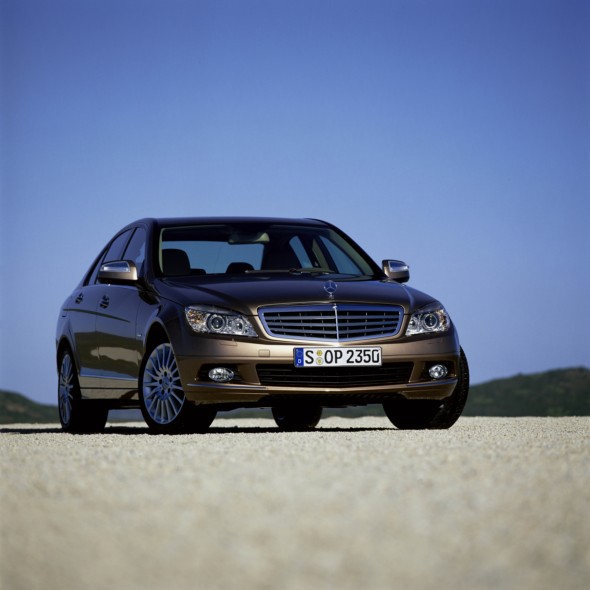
in a dangerous situation, PRE-SAFE® activates certain systems as a precaution to prepare the vehicle and its occupants for an impending accident. Accordingly the passive safety phase does not begin when the impact has already occurred, but before an impending collision.
The Intelligent Light System developed by Mercedes-Benz is also available in this vehicle class for the first time. Powerful bi-xenon headlamps provide five different lighting functions suited to typical driving and weather conditions: country mode, motorway mode, enhanced foglamps, the Active Light System and cornering lights. Yet another important contribution by Mercedes-Benz to safer driving in poor visibility.
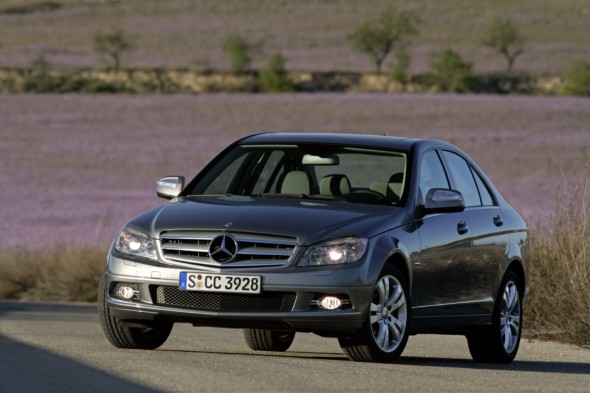
Interior design “cast from a single mould”
When developing the cockpit, Mercedes designers took their lead from the sporty sector and included clearly laid-out dial instruments such as may be found in roadsters or coupés. Silver-coloured bezels, black dial faces, white markings and glowing orange needles perfectly combine form with function for a high value impression and easy legibility.
Equally clearly laid out and well-arranged, the two-tone dashboard and centre console of the new C-Class form a harmonious unit in line with the “design cast from a single mould” principle. The same applies to the integration of the colour display at the upper centre of the dashboard.
This is perfectly positioned within the driver’s line of vision, but can also be covered or folded away as required, without switching off the radio, navigation system or other units linked to the display. If the pivoting cover of the display aperture is closed, the infotainment units continue to operate.
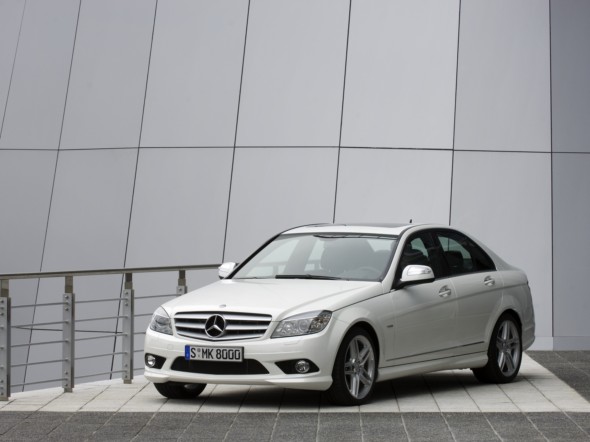
New control concept for clarity and comfort
The central colour display is part of the new control and display concept which the new C-Class has adopted from the luxury-class Mercedes models. Its major advantage is rapid access to frequently used functions, which means that the driver does not need to relearn, is able to maintain familiar habits and feels at home immediately.
All the control and display elements necessary and important during a journey are located in the cockpit, i.e. in immediate proximity to the driver.
In the same way, linking the standard multifunction steering wheel with the instrument cluster is an important precondition for rapid access to a wide range of information and functions in the driver’s direct line of vision. Other functions such as infotainment are shown by the display at the centre of the dashboard.
The driver and front passenger are able to control the radio, navigation system or telephone by using a controller on the centre console, or access the main menus using direct selection keys.
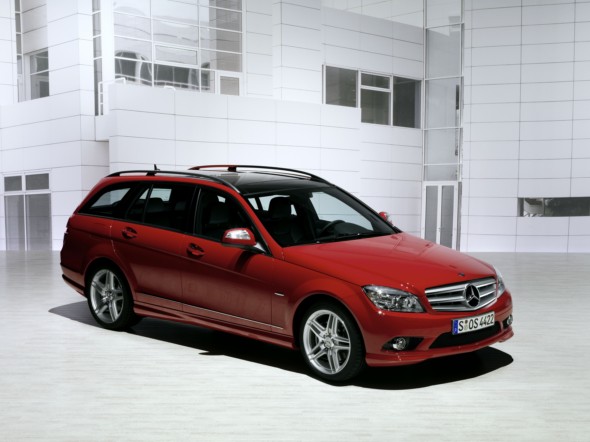
COMAND provides voice operation, a music server and DVD navigation The Audio 20, Audio 50 APS and COMAND APS systems are a range of newly developed, optional infotainment units for C-Class passengers. They all feature a keypad for entering telephone numbers and radio frequencies, as well as a Bluetooth interface which wirelessly connects the mobile phone to the handsfree system. In the Audio 50 APS, the route guidance information – some of it as a visually attractive automatic junction zoom display – is shown by means of arrows on the fixed colour display (4.9-inch) in the dashboard. An integral 6-CD changer and the LINGUATRONIC voice control system are available on request.
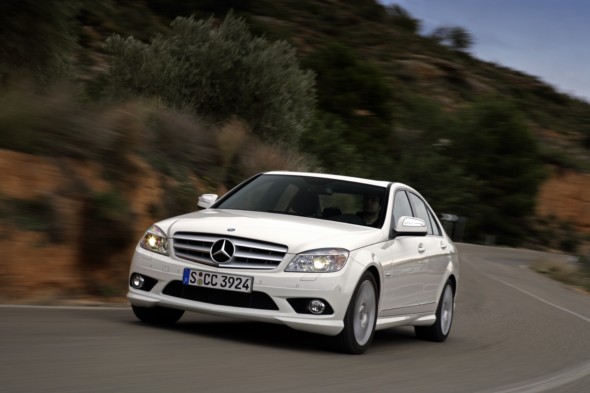
The multimedia system COMAND APS offers even more functions than before in the new C-Class. One new feature is a Europe-wide navigation system whose data are stored on a hard disc (30 gigabytes). The high-resolution maps are shown on a colour display (7-inch) which pivots away and disappears beneath a cover at the touch of a button.
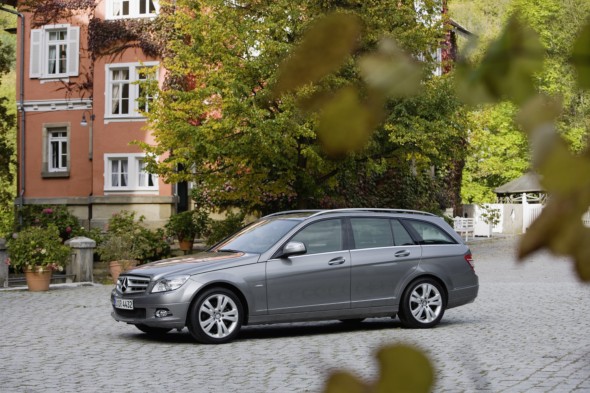
Other functions of COMAND APS include a music server with a four-gigabyte memory, a DVD-player for video and audio, and the LINGUATRONIC voice control system, which Mercedes-Benz has likewise improved further: the driver no longer needs to spell out the names of countries, towns or roads, but is able to speak them as whole words. The voice control system is just as convenient when selecting radio stations or entries in the telephone directory. The C-Class is the bestseller in the Mercedes lineup The new C-Class Salon replaces a model series of which more than 1.4 million units have been sold since spring 2000.
All in all, Mercedes-Benz has delivered more than two million of the Saloon, Estate and Sports Coupé models in the previous C-Class to customers all over the world. This makes the C-Class the bestseller in the Mercedes-Benz passenger car range. Germany is the largest market for the C-Class, accounting for around 30 percent of worldwide sales.
Appointments and technical highlights of the new C-Class*
Cornering lights: This function of bi-xenon headlamps and the Intelligent Light System provides more safety on junctions and when driving slowly on tight bends. Optional in conjunction with bi-xenon headlamps or the Intelligent Light System
ADAPTIVE BRAKE: This newly developed braking system has support functions for even more safety and comfort.
Adaptive brake lights: Flashing brake lights warn vehicles behind in an emergency braking situation.
Adaptive front airbags: The front airbags deploy in two stages, depending on accident severity.
ADVANCED AGILITY package: Shock absorber and transmission settings can be modified at the touch of a button – either for comfort or sporty agility. The steering is more direct, and in Sport mode the accelerator characteristics are adapted. If an automatic transmission is specified, the shift characteristics are also modified.
AGILITY CONTROL package: A selective damping system adapts the shock absorber responses to the driving situation. The AGILITY CONTROL package also includes more direct steering and gearshifts with a short travel.
Active Light System: The bi-xenon headlamps follow the driver’s steering movements. Optional in conjunction with Intelligent Light System
Motorway mode: From 90 km/h the entire width of the carriageway is illuminated, improving the driver’s range of visibility by around 50 metres. Optional in conjunction with Intelligent Light System
Bi-xenon headlamps: Gas-discharge lamps for dipped and high beam improve safety at night.
Optional Bluetooth interface: The mobile phone is wirelessly linked to the hands-free system. Optional in conjunction with Audio 20, Audio 50 APS or COMAND APS
COMAND APS: The data of the navigation system are stored on a hard disc for even faster route calculation and better representation of the route on the display. A music server for up to 1000 tracks is also integrated.
Enhanced foglamps: This function of the Intelligent Light System pivots the offside headlamp outwards to illuminate the road verge more effectively. Optional in conjunction with Intelligent Light System
ESP®: This safety system is able to reduce the risk of skidding on bends, and warns of pressure loss in the tyres.
Headlamp Assist: A sensor on the windscreen automatically switches the headlamps on when darkness falls.
Belt force limiters: This technology reduces the belt forces acting on the occupants during a crash. Standard for the front and outer rear seats
Belt tensioners: Seat belt slack is instantly taken up during a crash to reduce the forward movement of the occupants. Standard for the front and outer rear seats
Intelligent Light System: This innovative headlamp technology provides five lighting functions which are activated depending on the driving and weather conditions (also see Cornering lights, Country mode, Motorway mode, Active Light System and Enhanced foglamps).
KEYLESS-GO: The doors and boot lid can be opened without a key. The engine is started at the touch of a button.
Child seat recognition: A transponder system automatically recognises whether a rear-facing child seat is installed, and deactivates the front passenger airbag if this is the case.
Kneebag: An additional airbag reduces the forward movement of the driver in the event of a crash.
Standard**
THERMATIC automatic climate control: This improved system controls two temperature zones and features numerous adjustments for individual climatic comfort.
THERMOTRONIC luxury automatic climate control: This system provides three-zone climate control, and includes other functions such as diffused, draught-free ventilation and a combination filter with an air quality sensor.
Luxury multifunction steering wheel: The radio, telephone, navigation system, display and other units can be operated from the steering wheel. Standard in the ELEGANCE and AVANTGARDE lines
Paintwork: Nano-technology makes the paint finish more scratch-resistant and ensures a glossier sheen.
Standard Country mode: This function of the Intelligent Light System replaces the previous low-beam headlamps and illuminates the offside road edge more effectively. Optional in conjunction with Intelligent Light System
LINGUATRONIC: The voice control system operates the radio, CD/DVD-player, CD/DVD-changer, navigation system and telephone – now by whole-word commands.
Optional; standard in conjunction with Audio 50 APS with 6-DVD changer and COMAND APS
Memory function: Three memory settings are stored for the driver and front passenger. The settings for the steering wheel and exterior mirrors are also stored. Optional in conjunction with electrically adjustable front seats
Multicontour seats: Inflatable air chambers enable the seat contours to be adjusted to the individual occupant.
NECK-PRO head restraints: Crash-responsive head restraints support the heads of the driver and front passenger at an early stage during a rear-end collision, reducing the risk of a whiplash injury.
Panoramic sliding roof: A large glass surface extending from the front to the rear window. The front section slides to the rear at the touch of a button.
PARKTRONIC: Ultrasonic sensors assist the driver when parking.
PRE-SAFE®: Anticipatory safety measures are taken to protect the occupants if an accident risk is detected.
Sidebags: These side airbags reduce the risk of injury in a lateral collision.
Standard for driver and front passenger; optional for the rear
Seven-speed automatic transmission 7G-TRONIC: The world’s only automatic car transmission with seven ratios is optionally available with the V6-engines. Optional in conjunction with V6-engine; standard in C 350
Sound system: A multi-channel system with innovative digital technology provides surround-sound on every seat. A unique quality of Dolby 5.1 sound is experienced with the DVD-player.
Windowbags: This large airbag extends from the A to the Cpillar like a curtain during a side crash.
*Selection **in the Euro NCAP countries
25 years of the C-Class: From the “Baby Benz” to a bestseller
Stuttgart — 25 years ago, Mercedes-Benz introduced the Model 190 and laid the foundations for what has become the bestselling model series in the history of the brand: the C-Class. To date around six million C-Class Saloons, Estates and Sports Coupés have been delivered to customers.
On March 31, 2007 the fourth generation of this bestselling Mercedes will appear in the showrooms of company-owned Mercedes sales outlets and dealerships throughout Europe to continue this success story. Around 60,000 orders have already been received for the Saloon.
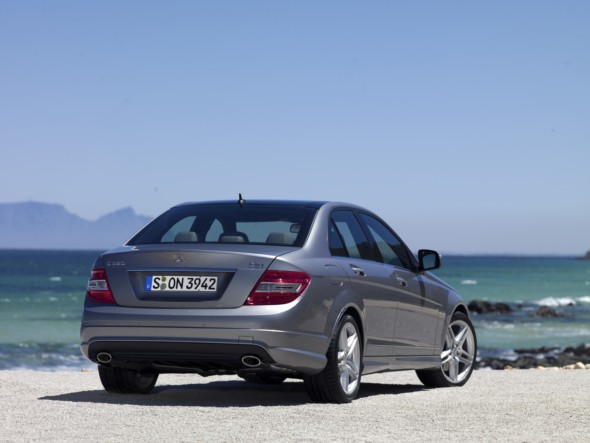
At the beginning of the 1980s, the news that Mercedes-Benz was working on a new model series below the E-Class was a sensation, and gave rise to a great deal of speculation. Seldom before had the press reported so often and so exhaustively about a secret prototype as about the “compact” Mercedes-Benz, which soon became world-famous as the “Baby Benz” even before its launch.
The new car was the culmination of many years of deliberation for the Stuttgart brand. The compact Saloon met the wishes of car buyers, while offering Mercedes-Benz the opportunity to establish itself in a new market segment and gain additional customers.
Moreover, there were increasing calls for more economical cars, and with the Model 190 Mercedes-Benz was able to demonstrate that its typically high standards of safety and comfort could also be realised in a more compact and economical model.
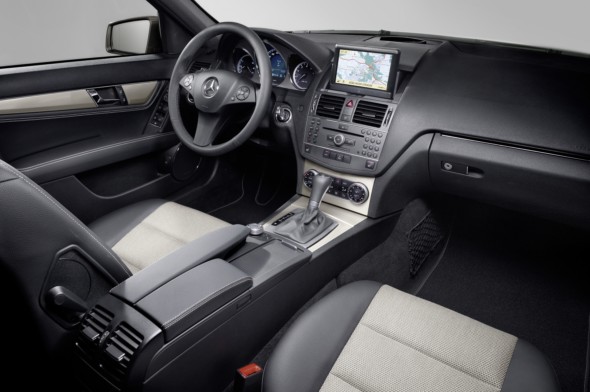
Accordingly the requirements confronting the development engineers were very stringent, as they needed to reconcile fuel consumption related criteria such as a low weight and good aerodynamics with Mercedes standards of occupant safety, handling stability, comfort and quality.
The aim was to develop a true Mercedes-Benz which was 30 centimetres shorter, ten centimetres narrower and 280 kilograms lighter than the Mercedes medium range at the time (W 123), and which would consume an average of only 8.5 litres of fuel per 100 kilometres. The engineers were able to achieve their goal with the help of the latest development and calculation tools, as well as the use of newly developed lightweight materials.

Accordingly the Mercedes-Benz 190 also became a technological trendsetter in automobile engineering. Trailblazer for future-oriented technology and a new design idiom The Saloon was well ahead of its time, with a safety concept that reflected the results of accident research and already took offset frontal collisions into account.
Neither was any other car in this class able to offer an anti-lock braking system, bent tensioners and an airbag, which were available as optional equipment, in the early 1980s. The still unrivalled multi-link independent rear suspension celebrated its world debut in the Mercedes-Benz 190, as did the first high-strength steel alloys which combine minimal weight with maximum strength.
Mercedes-Benz also broke new ground with the Model 190 where design was concerned. The angular, trapezoid form of the bodyshell and unusually high rear end ensured plenty of attention. Mercedes-Benz later transferred these basic lines to other model series – making the “Baby Benz” the pioneer of a new design idiom which characterised saloons bearing the Mercedes star until the early 1990s.
The design concept also reflected the latest technical findings, for the high, tucked-in rear end enabled the engineers to lower the air resistance of the bodyshell considerably. The resulting drag coefficient of 0.33 was 25 percent below the average for all passenger cars at the time.
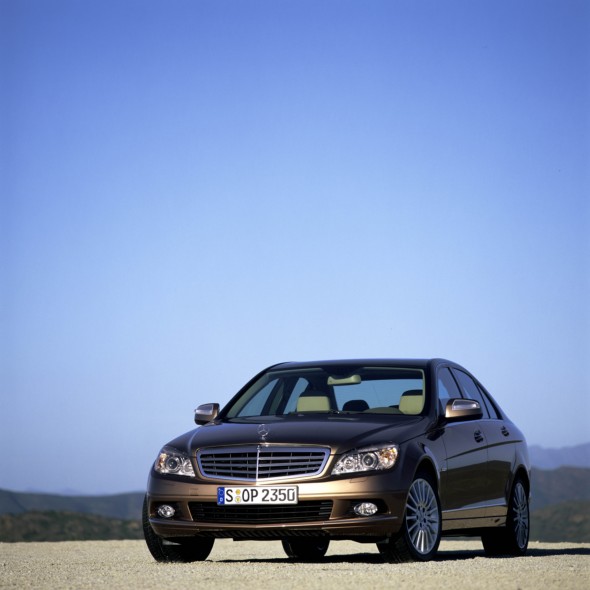
In this way intelligent lightweight construction and exemplary aerodynamics provided two important prerequisites for a favourable fuel consumption. The Mercedes-Benz 190 with the 66 kW/90 hp four-cylinder carburettor engine had a Euromix petrol consumption of 8.5 litres per 100 kilometres, while the 190 E (90 kW/122 hp) with the first mechanically/electronically controlled fuel injection system was able to cover 100m kilometres on just 8.3 litres of petrol.
In autumn 1983 Mercedes-Benz rounded off the engine range with a newly developed diesel unit. The 190 D (53 kW/72 hp) was happy with 6.6 litres of fuel per 100 kilometres.
More than two decades later, there are still more than 23,000 examples of the “Baby Benz” on the roads Many drivers still benefit from the technical perfection and high quality of this Mercedes Saloon to this day. Around 230,000 examples of the Mercedes-Benz 190 are still registered in Germany, and 23,290 that were first registered between 1983 and 1985 are still on the active list at the Federal Motor Transport Authority (KBA).
This represents no less than around eight percent of the 190s first registered in that period. According to the KBA, only between 251 and 10,383 examples of other, comparable saloons registered from 1983 to 1985 are still on the active list.
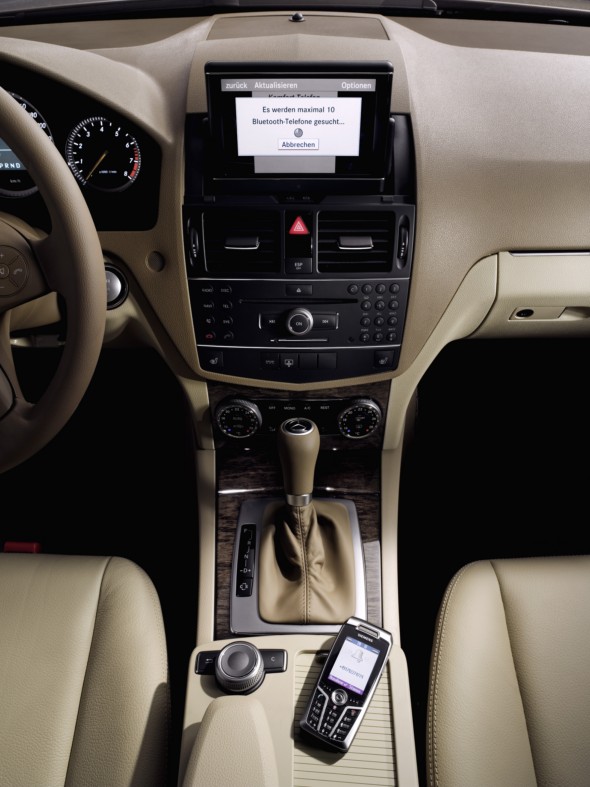
Around 60,000 advance orders for the new C-Class Like the Mercedes-Benz 190 introduced 25 years ago, the new C-Class sets new trends in design and technology. No other car in this vehicle class is able to offer Mercedes safety innovations such as the preventive occupant protection system PRE-SAFE® and the Intelligent Light System.
The new C-Class also asserts its leading position in this market segment with the ADAPTIVE BRAKE system and the situation-related shock absorber control system of the AGILITY CONTROL package. There is a choice of four and six-cylinder engines generating up to 13 percent more output than before, while consuming up to six percent less fuel.
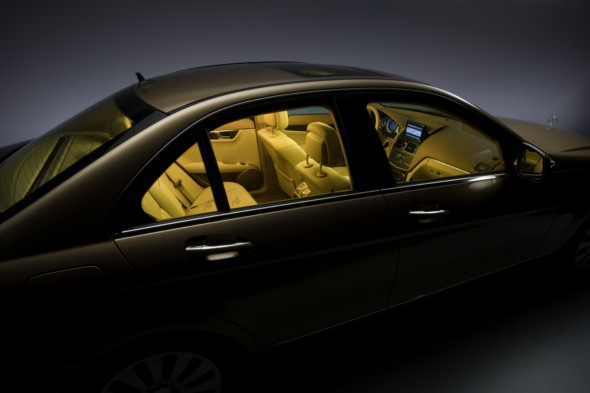
Apart from the S-Class, the new C-Class is the only car worldwide to possess an official environmental certificate which confirms the environmentally compatible development of this Mercedes model. Two weeks before the official market launch, around 60,000 male and female drivers in western Europe alone have already decided in favour of the new C-Class Saloon and placed an order.
Ambassador for a new Mercedes design idiom A look back at 25 years of the C-Class also reveals parallels between the two Saloons in styling terms. Both represent something new for their time, and both have set design trends. Just as the trapezoid, “cut diamond” design of the Mercedes-Benz 190 paved the way for a future Mercedes design idiom in its time, the new C-Class is also an ambassador for a new design style.
The emphasis here is on purity of form, with the designers following the rules of modern purism and reinterpreting them in a modern context. Owing to an interplay between tightly drawn lines and large, tranquil surfaces, the design expresses unruffled calm and power, and symbolises the technical superiority of cars bearing the Mercedes star.
Mercedes-Benz first realised this new design idiom in the S-Class in 2005. The C-Class is yet another representative of these design lines, and therefore follows in the footsteps of the luxury models in the S and CL-Class – not as a copy, but as an individual and autonomous interpretation.
25 years ago, the Model 190 also marked a new styling departure with a redesign of the tradition-laden Mercedes radiator grille, which was no longer mounted but rather flush-fitted into the front end. In the new C-Class the radiator grille is likewise an important design feature with a high symbolic effect.
This is because for the first time in a Saloon, Mercedes-Benz has used the radiator grille to position certain attributes even more unmistakably. With their three-dimensionally contoured radiator grille, the CLASSIC and ELEGANCE lines intentionally echo certain striking features of the S-Class to symbolise attributes such as solidity, power and luxury.
In the AVANTGARDE line, the designers have opted for a visually even more striking radiator grille with wide louvres and a large, centrally located Mercedes star. This typical feature of the sporty Mercedes models underlines the dynamic, agile character of this model.
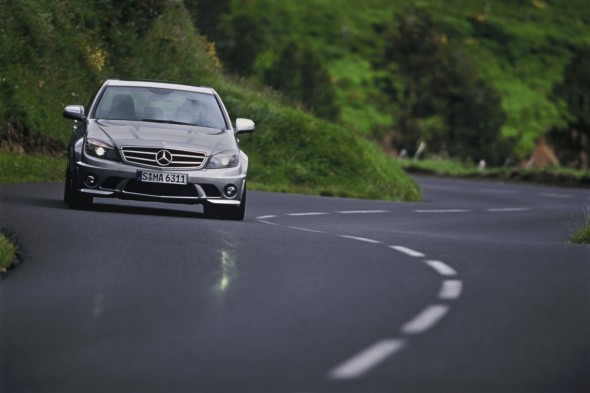
Mercedes classics with a 150 percent value increase in just a few years Long-term quality in both design and technology is the major reason for the high value retention of Mercedes passenger cars. They achieve the highest resale prices in almost all age and vehicle categories, and have therefore gained an enviable reputation as “value retainers”.
The Model 190 shows that a 25 year-old Mercedes-Benz does not look “old”, but still cuts a good figure on the road. This timeless appeal is common to all Mercedes models, and is accompanied by a degree of technical reliability.
Both attributes are essential for “value retainers” to become automotive classics — and for the purchase of a Mercedes-Benz to be a long-term investment with high potential returns.

Accordingly Mercedes-Benz is also the leading brand in the classic car market. Many of the models bearing the star on their bonnet are highly desirable collectors’ items whose value increases from year to year. The roadsters, convertibles and coupés of the 1950s and 60s are particularly sought-after, above all the legendary 300 SL “Gullwing” and the 300 SL Roadster.
Their value increased by up to 150 percent between 1998 and 2006, and a Gullwing Coupé for which collectors paid around 205,000 Euro in 1998 is now worth well over 510,000 Euro. In 1998 the 300 SL Roadster had a price tag of around 153,000 Euro – but today this dream car achieves prices of 385,000 Euro or more.
The specialists at the Mercedes-Benz Classic Center consider a model from the first C-Class generation to be among the classics of the future: the Mercedes-Benz 190 E 2.3 16 or 190 E 2.5 16. Only 25,200 examples of this sporty Saloon with a 16-valve engine were produced, and this alone makes it a rarity with a high potential return.

Model range
Superior agility
Superior: perfect synthesis of safety, comfort and agility
Striking: AVANTGARDE with styling features from the sporty Mercedes models
Seminal: debut of the latest safety systems from the luxury class
How do you make a bestseller even more successful? How do you consolidate a leading position even further? How do you combine automotive emotion and intelligence even more closely?

These were no easy tasks for the product planners, designers and engineers when it came to creating the concept for the new C-Class.
Foresight was needed to assess developments in the markets, sensitivity to reconcile the wishes of present customers with the expectations of new buyer target groups, and expertise to achieve new technical masterstrokes at the previous, high level. In short, the C-Class project was an exciting and interesting mission in every respect.
And a challenge that was mastered with real aplomb: the Saloon has gained a new profile, with a more self-assured, imposing and stylish presence than ever before.
While the C-Class is and remains a typical Mercedes-Benz with everything that traditionally characterises the Stuttgart brand, it offers even more. Its special feature is a synthesis of agility and comfort which has never previously been achieved in this vehicle class. This interaction creates the conditions for a new, extraordinary driving experience.

The new C-Class possesses a product profile which meets the needs of different target groups. It is comfortable without seeming sedate, sporty without becoming uncomfortable and youthful without being adolescent. In other words, the C-Class is superior in every respect – full of character and autonomous.
Lines: clear differentiation between different characteristics As before, there is a choice of three design and equipment lines to emphasise the typical attributes of the new Saloon more strongly, and to suit its appearance to personal tastes and lifestyles. In the case of the new C-Class, this individuality is even more important than in the preceding model, however.
Mercedes customers are able to highlight the aspects of e.g. comfort or agility even more than before, and the design and equipment lines reflect the different characteristics, and therefore the lifestyles of their drivers, even more expressively. Thanks to these lines, the C-Class is a “product-in-product” concept.
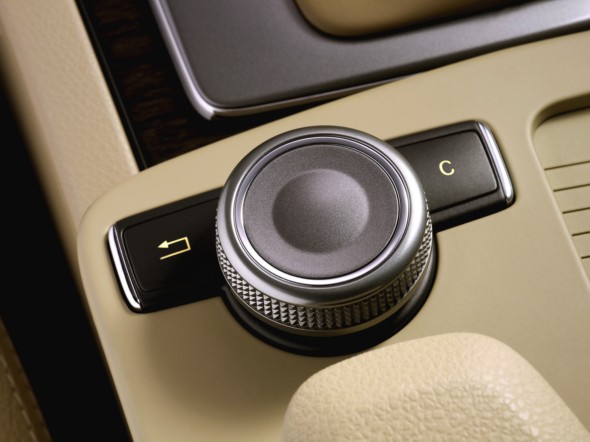
The youthful, progressive line is named AVANTGARDE. This is where the sporting genes of the Mercedes-Benz brand come to the fore, especially by virtue of the radiator grille with its three high-gloss louvres and large, centrally positioned Mercedes star.
This design element has long been recognised as a typical feature of the more sporty Mercedes models by car lovers. It now embellishes the Saloon as an unmistakable expression of its inherent attributes, namely agility, power and performance.
Standard 17-inch light-alloy wheels in a five twin-spoke design, wide-base tyres in size 225/45 R 17, aluminium interior trim (optional: bird’s-eye maple) and other stylish details accentuate the sporty, superior appearance of the AVANTGARDE model, which also does full justice to well-proven C-Class attributes such as safety and long-distance comfort.
In the ELEGANCE line the emphasis is on the traditional values of a Mercedes saloon – and especially on comfort. The external appearance is enhanced by the attractively integrated, chrome-embellished radiator grille and chrome inserts in the bumpers, side rub strips and boot lid.
Exotic wood trim in eucalyptus (optional: burr walnut) brings typical Mercedes flair to the interior, which also provides a welcoming atmosphere with its warm colour tones and combinations.
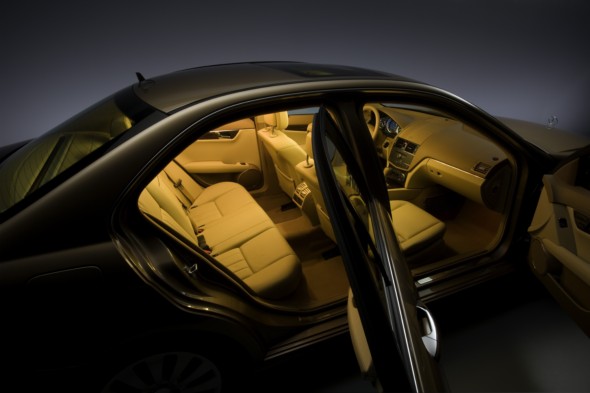
In this line too, the C-Class remains true to its basic character and offers not only typical Mercedes comfort, but also the handling agility that makes the driving experience perfect. The CLASSIC line is designed to appeal to male and female drivers who do not wish to reveal the potential of their C-Class at first glance.
Both inside and out the Saloon is characterised by classic restraint, however its extensive range of standard appointments includes all the technical innovations that make for the superior presence of this new Mercedes model where safety, comfort and agility are concerned.
Mercedes-Benz C 63 AMG A C-Class like never before
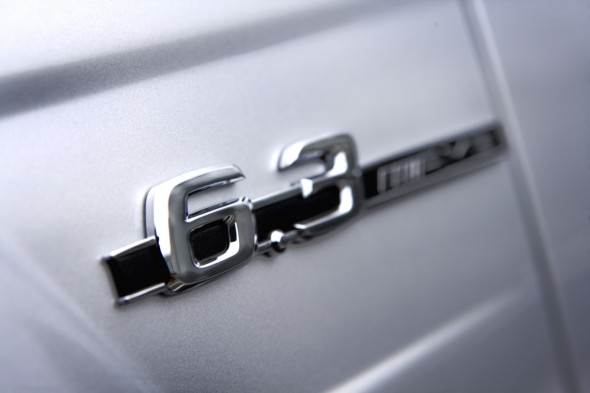
Mainz/Affalterbach – In the German Touring Car Masters (DTM) the new AMG C-Class ensures exciting motor racing at the highest level. And now its road-going sister model is celebrating its debut: the new C 63 AMG. Available in saloon and estate versions, the top C-Class model is powered by an AMG 6.3-litre V8 engine.
Developing a peak output of 336 kW/457 hp and a maximum torque of 600 Nm, the high-revving, naturally aspirated engine delivers unrivalled figures in this segment. The C 63 AMG accelerates from zero to 100 km/h in 4.5 seconds (estate 4.6 seconds); the top speed is electronically limited to 250 km/h.
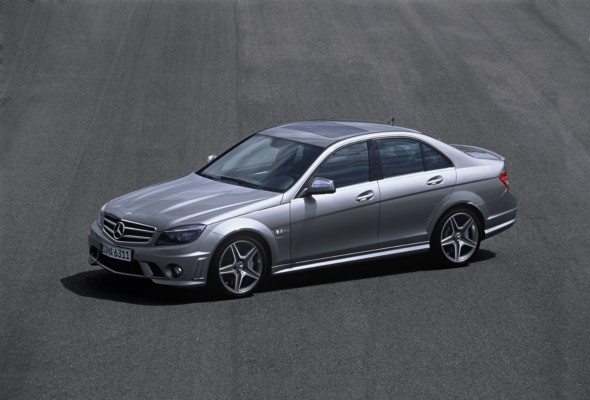
Power transmission is in the capable hands of the AMG SPEEDSHIFT PLUS 7GTRONIC. Equipped with AMG steering-wheel shift paddles and featuring three drive programs, the seven-speed automatic offers everything from a seriously sporty to a comfort-oriented driving style. The revving function when changing down is a completely new feature.
In conjunction with the newly developed front axle, AMG speed-sensitive sports steering and the new, 3-stage ESP®, the AMG sports suspension with 18-inch AMG light-alloy wheels ensures both outstanding driving pleasure and exemplary driving dynamics.
The AMG high-performance brake system with large-dimensioned internally ventilated and perforated disc brakes all-round ensures flawless deceleration even during highly dynamic driving.
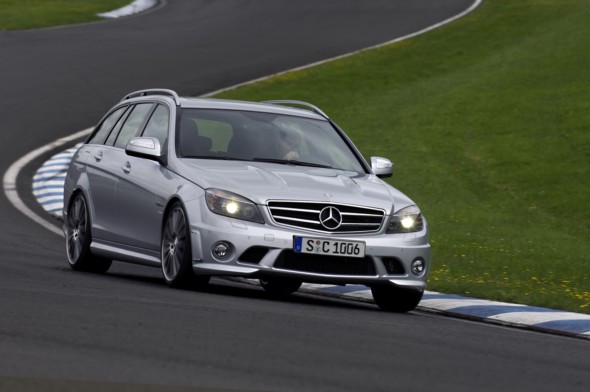
Design and equipment: more distinctive than ever before The quality of design and equipment in the new C 63 AMG is more than a match for its outstanding technology.
The AMG eight-cylinder top model differentiates itself from the production C-Class more than ever before: in addition to AMG bodystyling, characteristic brand features include the bonnet with power domes, the distinctive AMG radiator grille, flared front wings, the AMG rear apron with a black diffusor insert, the AMG sports exhaust system with two chromed twin tailpipes and the AMG spoiler lip.
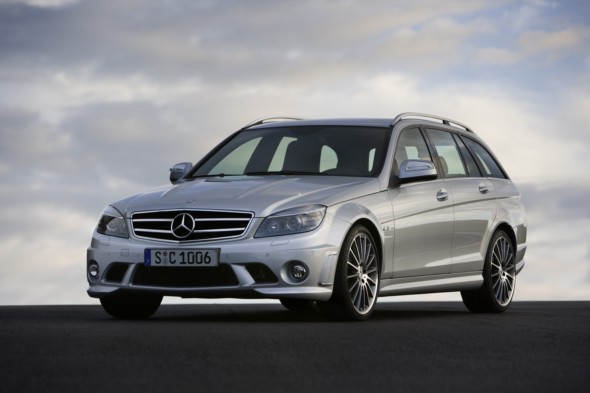
The interior is dominated by the distinctive AMG sports seats with integrated head restraints, the AMG performance steering wheel in a three-spoke design with a 365-mm rim diameter and a flattened lower section as well as the tubular-design AMG instrument cluster with its AMG main menu.
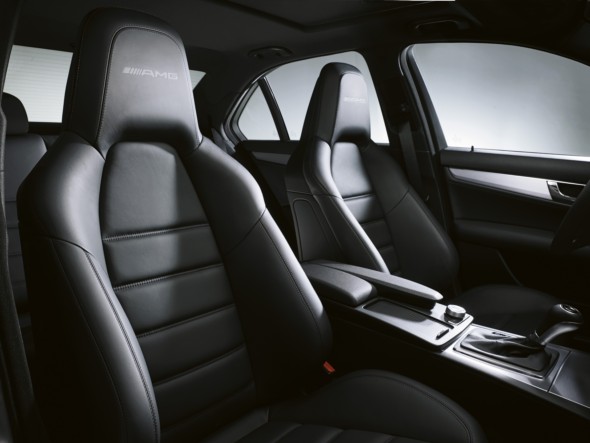
The combination of expressive design, a decidedly sporty interior and superb everyday practicality makes the C 63 AMG a unique high-performance vehicle. The market launch of the saloon and estate models will commence in early 2008. Retail prices incl. 19% VAT will be 67,235 euros (C 63 AMG Saloon) and 69,853 euros (C 63 AMG Estate).
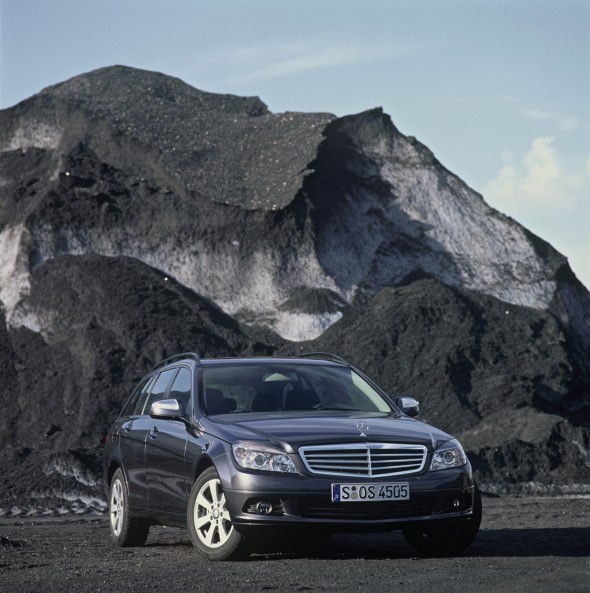
190 E 3.2 AMG from 1987 was the inspiration for the C 63 AMG To coincide with the 40th birthday of Mercedes-AMG GmbH, the new C 63 AMG cuts a very self-assured figure. The V8 top model is already the fifth generation of the AMG C-Class.
The family tree goes right back to the 1993 C 36 AMG – the very first vehicle to emerge from the cooperation between Daimler-Benz and AMG. But the first steps were taken six years before. The 190 E 3.2 AMG unveiled in 1987 marked the beginning of the successful career of the dynamic and exclusive mid-range model from Affalterbach.
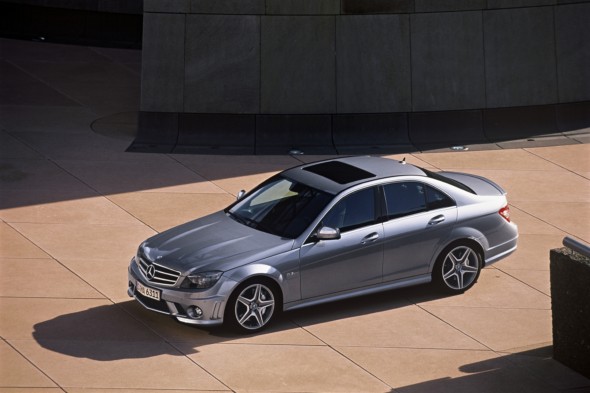
Page 1 Engine and drive system Engine capacity king with 336 kW/457 hp Wide, road-hugging and ready for action: the very appearance of the new C 63 AMG raises expectations. The bonnet with its prominent power domes is the first indication of the exceptional drive system of the new AMG highperformance car.
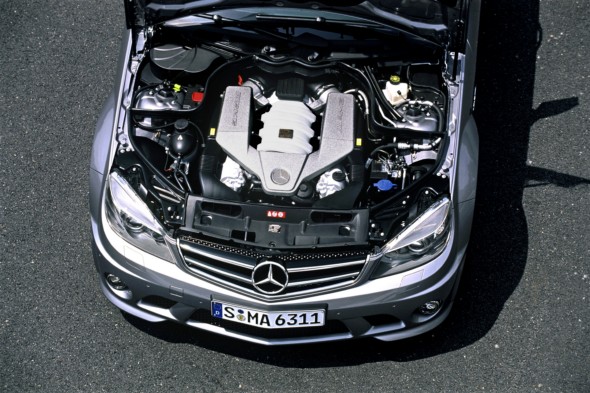
Under the bonnet you will find an independently developed AMG 6.3-litre V8 engine, which generates a dominant 336 kW/457 hp at 6800 rpm from a 6208-cc displacement. In this respect, the C 63 AMG comes very close to the 470 or so horsepower delivered by the AMG C-Class racing touring car in the German Touring Car Masters (DTM).
Such high output also benefits the power-to-weight ratio, which is a very favourable 3.6 kg/hp.

The torque developed by the AMG 6.3-litre V8 engine need also fear no comparison. The maximum 600 Nm at 5000 rpm is unrivalled in this class and the torque curve is equally impressive: from 2000 to 6250 rpm the driver always has more than 500 Nm on tap – ideal for powerful acceleration in any engine speed range.
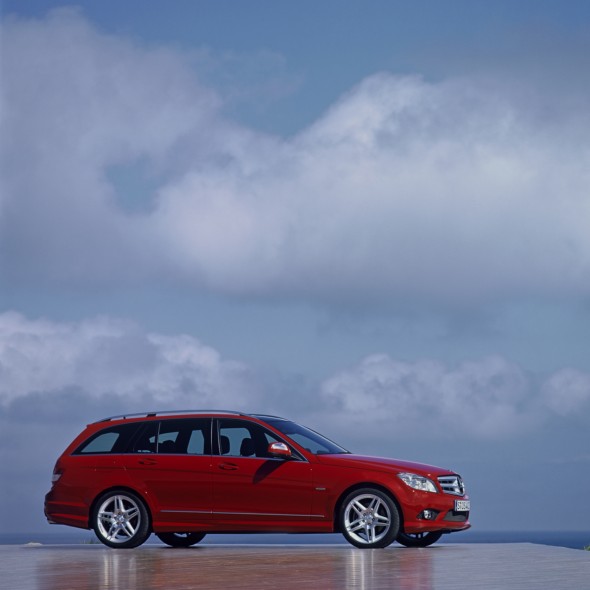
Thanks to its superior capacity, the AMG eight-cylinder engine delivers 30% more torque than comparable engines in its performance class. AMG 6.3-litre V8 based on thoroughbred racing technology Introduced in 2005, the V8 engine is installed in numerous AMG highperformance cars and excels with its thoroughbred motor sports technology.
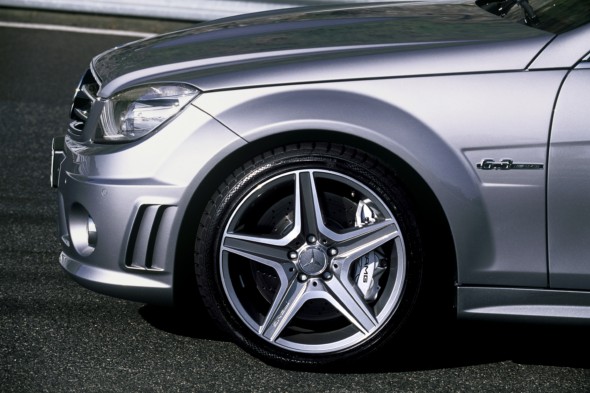
Perfect cylinder charging is ensured by the vertical arrangement of the intake and exhaust ducts, as well as the magnesium variable intake manifold with two integral throttle flaps. Other high-tech features include variable camshaft adjustment, four-valve technology with bucket-type tappets, a particularly rigid aluminium crankcase of closed-deck design and the low-friction TWAS coating on the cylinder contact surfaces.
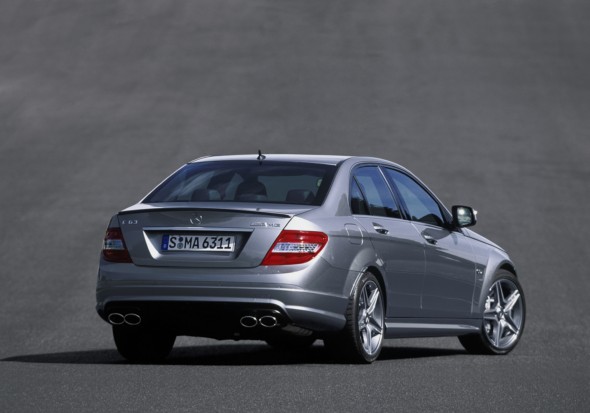
Key figures for the C 63 AMG at a glance:
Cylinder arrangement V8
Valves per cylinder 4
Displacement cc 6208
Bore/stroke mm 102.2/94.6
Compression ratio 11.3:1
Output kW/hp at rpm 336/457 6800
Max. torque Nm at rpm 600 5000
Acceleration 0 – 100 km/h s 4.5 (4.6)
Top speed km/h 250**
NEDC combined consumption in l/100 km 13.4 (13.7)
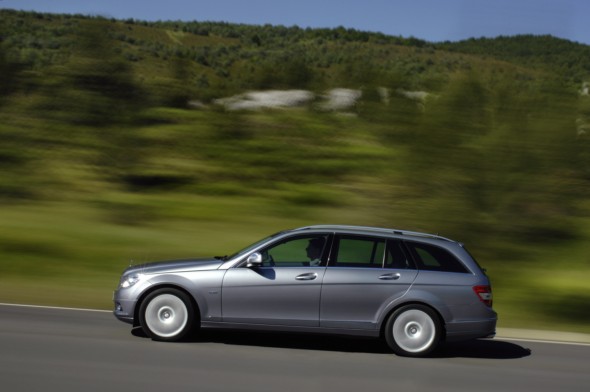
AMG sports exhaust system for typical AMG eight-cylinder vocals One of the outstanding strengths of the next-generation V8 engine from Mercedes-AMG is its high-revving flexibility. It reaches its maximum at 7200 rpm.
With an all-new sporty AMG sound developed during extensive testing, the eight-cylinder Affalterbach engine offers the unique appeal of a high-revving, naturally aspirated engine – unmistakable at low, medium and high engine speeds. To minimise exhaust back pressure, the continuous dual-flow AMG sports exhaust system features two chromed twin oval tailpipes with large crosssections.
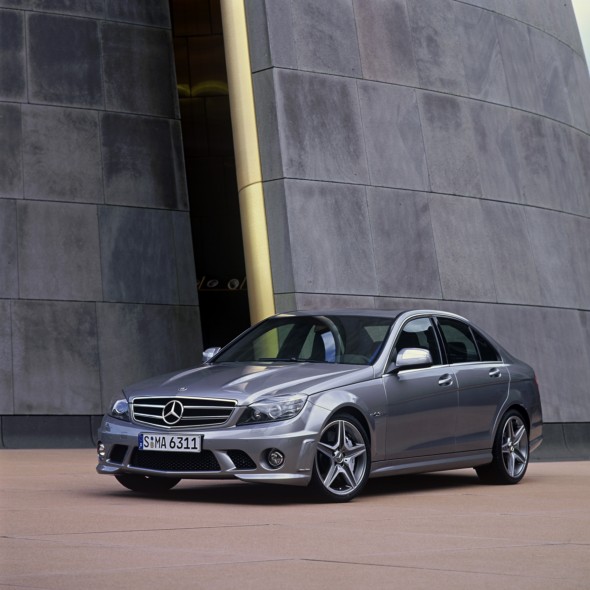
The high-performance catalytic converter technology ensures optimum emission control. And it goes without saying that the C 63 AMG complies with all current emissions limits, including EU 4. The specific requirements of the US market, such as the LEV-II standard, On-Board Diagnosis II and the lambda sensor diagnosis present no obstacle.
The fuel consumption of the C 63 AMG according to the NEDC is 13.4 l/100 km and 319 g/km CO2 (Estate 13.7 l/100 km and 326 g/km CO2).
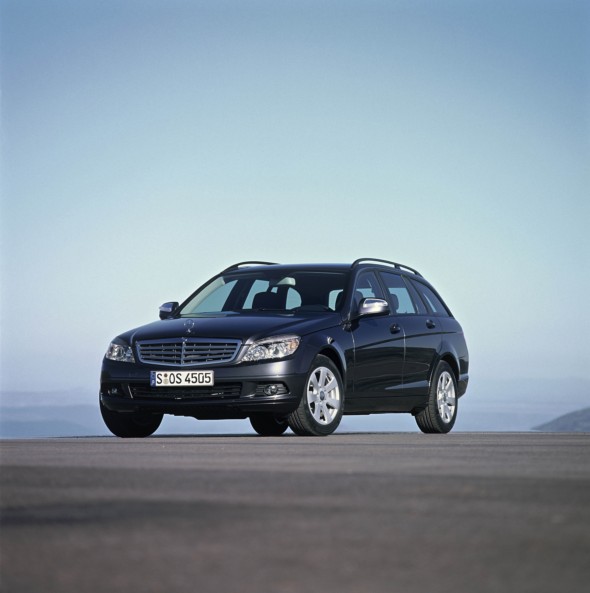
The inspiring agility and spontaneous response of the V8 engine to the touch of the accelerator also have their roots in electronic fuel supply. Equipped with new components, they operate at a demand-actuated system pressure of 3.8 to 5.0 bar. According to power requirements and external temperature, fuel pressure is adjusted and regulated at lightning speed.
The signal from the accelerator pedal is converted in milliseconds by the engine electronic system into the corresponding fuel pressure setting. Such control ensures rapid vehicle response and a sporty thrust across all load ranges and at all engine speeds.
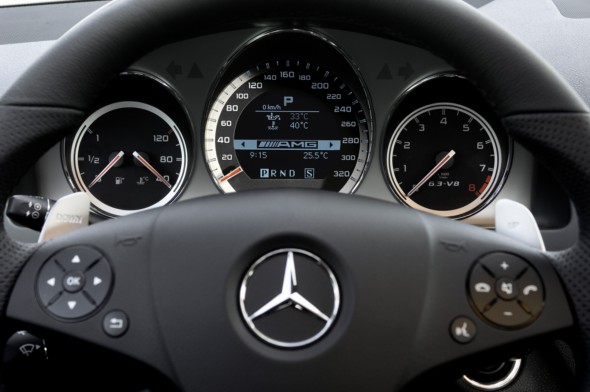
Large radiators for optimum stability In the interests of optimal reliability, the C 63 AMG has a particularly efficient water cooling system and large engine and transmission oil coolers. Located behind the large apertures in the AMG front apron, these coolers ensure non-critical operating temperatures at all times – even under the extreme stress of the racetrack.
Like all AMG high-performance engines, the AMG 6.3-litre V8 is built in the AMG engine shop on the traditional “one man, one engine” principle. This means that one technician is responsible for hand-assembling a complete V8 engine to the highest quality standards – which is attested to by their signature on the AMG engine plate.
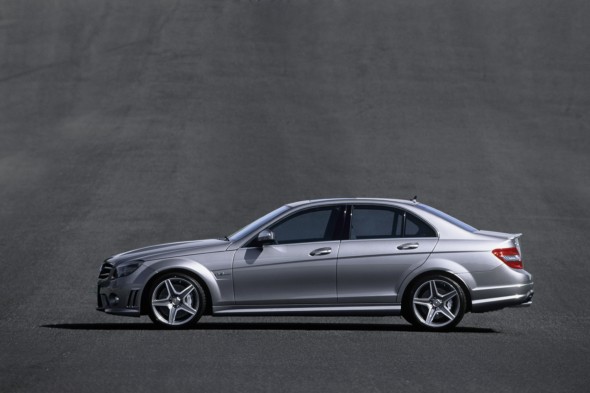
AMG SPEEDSHIFT PLUS 7G-TRONIC with blipping function This high-performance eight-cylinder engine has the perfect partner in the form of the AMG SPEEDSHIFT PLUS 7G-TRONIC transmission. Equipped with AMG aluminium steering-wheel shift paddles and three driving modes, the seven-speed automatic transmission allows a decidedly sporty or more comfort-oriented style of driving according to the driver’s preference.
The different modes – “S” (Sport), “C” (Comfort) and “M” (Manual) differ in their shift characteristics and speed: gearshifts in “S” mode are around 30% faster than in “C” and no less than around 50% faster in “M” mode. Pressing a button next to the selector lever is sufficient to activate the desired driving program.
The new C 63 AMG is the very first AMG car to feature an automatic throttleblipping function during downshifts. This not only enhances the driver’s emotional experience – the virtually jolt-free downshifting process also reduces the load-change responses and has a particularly positive effect when braking before bends on the racetrack.

Design and equipment
More AMG than ever before
Both technologically and visually the new C 63 AMG is more distinctively different from the production C-Class than ever before. In combination with the sports functionality of the standard equipment, the saloon and estate models are unmistakable in their role as exclusive and dynamic top models.
The front end of the C 63 AMG is dominated by the new bonnet with its two pronounced power domes, as well as the trademark AMG radiator grille with a central star and two louvres with chrome inserts.
The honeycomb pattern of the grille is also reflected in the large air dams of the new athletically contoured front apron, which forms part of the AMG-specific bodystyling. The front fog lamps with chrome surrounds are spaced well apart, acting together with the flared front wheel arches to accentuate the width of the car.
A real eye-catcher is the striking transition from the front apron to the wings. The side air vents in the front apron serve to expel the hot air from the oil coolers. If the C 63 AMG is ordered with the optional bi-xenon headlamps or the Intelligent Light System, the headlamps are also dark-tinted.
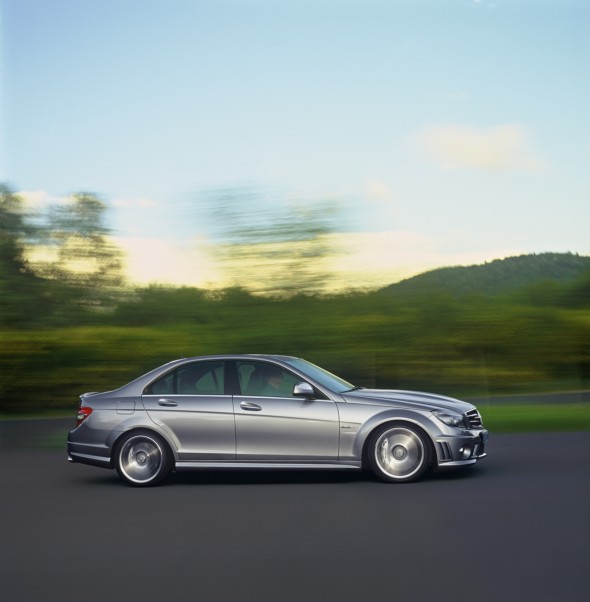
Eye-catching features when viewed from the side include the 18-inch AMG lightalloy wheels, the harmoniously integrated “6.3 AMG” lettering on the front wing and the AMG side sill panels.
At the rear, the standard LED rear lights, the AMG rear apron with its black diffuser insert and three pronounced diffuser fins, as well as the AMG sports exhaust system with two chrome twin tailpipes, provide further visual highlights that are hallmarks of the brand. The AMG spoiler lip on the boot lid (saloon only) reduces lift and ensures greater handling stability at high speeds.

Interior with new AMG sports seats and AMG performance steering wheel This decidedly sporty theme is continued in the interior of the C 63 AMG, which now has special AMG sports seats with integral head restraints for the first time. The seats not only feature a new design with cross-piping and AMG lettering, but also an adaptive backrest with adjustments for the side bolsters and lumbar support.
The standard upholstery in ARTICO man-made leather/AMG fabric is available in a choice of black or reef grey – or as an option the interior can be further enhanced with particularly high-grade nappa leather in black, reef grey or black/sahara beige.
Optimum handling control is assured with the new AMG performance steering wheel in a three-spoke design, which has a 365-mm rim diameter and a flattened lower section. The upper section is covered in perforated leather and two silver AMG shift paddles enable the gears to be shifted manually.

Other AMG-specific equipment features include the aluminium-look door sill panels with embossed AMG lettering and brushed stainless steel sports pedals. AMG main menu with a wide variety of displays The distinctive AMG instrument cluster in a tubular design was specially designed for the C 63 AMG.
It features newly styled dials, AMG-specific lettering and a new night-time design. Eye-catching details include the 320 km/h speedometer scale, AMG lettering, red needles and the “6.3 V8” logo in the rev counter.
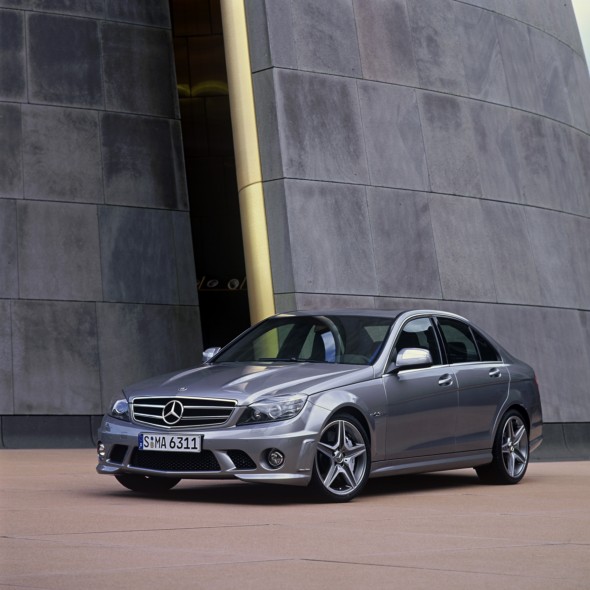
The AMG main menu in the central display allows numerous settings, with “Warm Up”, “Set Up” and “RACE” modes activated via multifunction buttons on the AMG performance steering wheel.
“Warm Up” displays the engine oil and coolant temperature, “Set Up” the current ESP® mode and the transmission mode “S”, “C” or “M”. “RACE” mode makes the RACETIMER available, with which the driver is able to measure lap times on a racetrack.
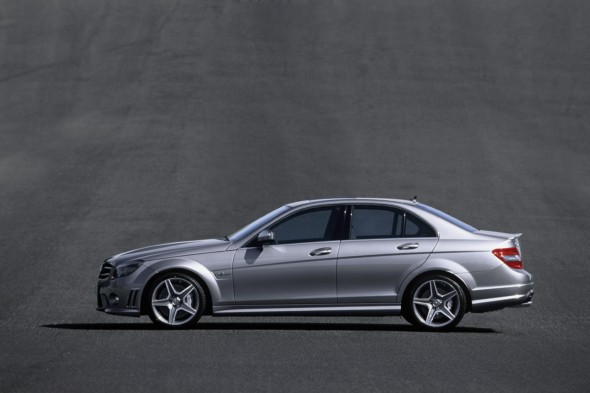
C 63 AMG Estate with maximum cargo volume of 1500 litres In developing the new C 63 AMG Estate, the designers and engineers focused on customer expectations. A spacious interior, variability and functionality were afforded priority. Unlike its predecessor, the rear of the new Estate is considerably more steeply raked – an important factor that generates a larger load capacity.
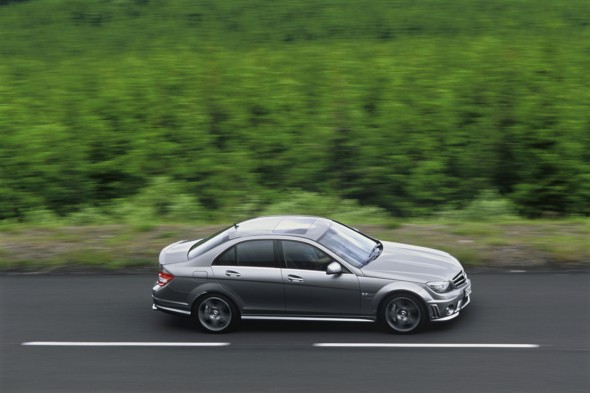
The capacity is 485 or 1500 litres according to the position of the 1/3:2/3 splitfold rear seat backrest (VDA measuring method). No other vehicle of the premium estate segment in this vehicle category offers so much space. The load capacity has increased by up to 146 litres compared to its predecessor.
Every aspect of the C 63 AMG Estate is suitable for everyday use. It has room for four golf bags with trolleys, for example. The largest possible cuboid measurement has increased by 66 litres to 827 litres, which exceeds other premium estates in its vehicle category by anything from 50 to 100 litres.
The maximum load compartment length measures 2.82 m from the tailgate to the front-passenger footwell – an increase of 17 cm.
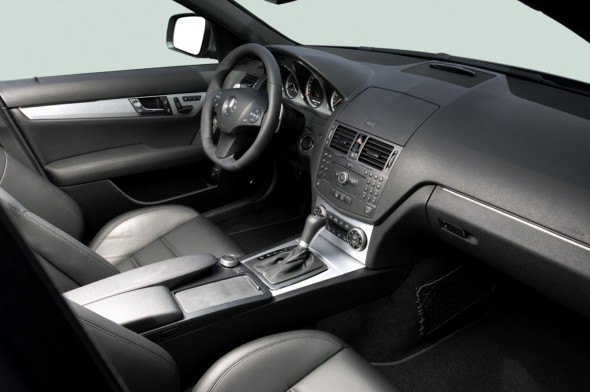
Easy loading: EASY PACK tailgate and load-securing kit A series of practical details make loading the new C 63 AMG Estate even easier, more comfortable and safer. The load compartment features two bag hooks and four lashing rings for securing cargo. Standard equipment includes side stowage compartments with net covers and a collapsible shopping box as well as a combined luggage cover and safety net.
The new optional EASY-PACK tailgate opens and closes at the touch of a button and with the EASY-PACK load-securing kit (optional extras) drivers have even more options for dividing the load compartment (approx. 1.80 x 1.20 m) and securing their cargo.
C 63 AMG standard equipment includes (selection):
- Adaptive brake light
- Airbags for the driver and front passenger
- Aluminium trim panels on dome, doors and centre console
- Acceleration skid control (ASR)
- Armrest with roller-top compartment
- Electrically adjustable and heated exterior mirrors
- Outside temperature display
- Brake Assist
- ADAPTIVE BRAKE system with hill-start assist
- Combined luggage cover and safety net (estate)
- Through-loading facility and armrest with double cup holder, load securing and 1/3:2/3 split-fold rear seat backrest (saloon) • 1/3:2/3 split-fold rear seat backrest (estate)
- Shopping crate, collapsible (estate)
- 3-stage ESP®
- Headlamp Assist
- Power windows (4)
- Belt tensioners and belt force limiters for the front and outer rear seats
- Air-conditioned glove compartment
- Black roof liner
- ISOFIX child seat attachment points in the rear
- Map pocket on the rear of the driver’s seat backrest
- THERMATIC two-zone automatic climate control
- Kneebag on the driver’s side**
- Steering column adjustable for height and reach
- Lighting package
- Front fog lamps
- Projector-beam headlamps with halogen technology
- Tyre pressure loss warning system
- ELCODE locking system with infrared/radio remote control
- Sidebag for driver and front passenger
- Bag hooks in the boot/luggage compartment
- Cruise control with SPEEDTRONIC variable speed limiter
- Front seats electrically adjustable for height and backrest angle
- Leather selector lever
- Tinted glass
- Windowbags
- Central locking with crash sensor
** in Europe
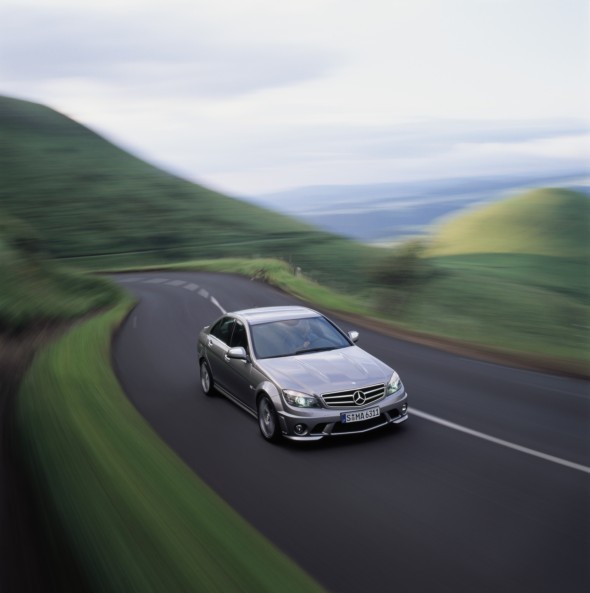
Optional extras include:
- 19-inch AMG light-alloy wheels
- AMG performance package
- AMG carbon-fibre trim
- AMG velour floor mats
- Bi-xenon headlamps with cornering light function and headlamp cleaning system – including dark-tinted headlamps
- COMAND APS, incl. hard disc navigation, LINGUATRONIC voice control and music server, on request also with 6-DVD changer
- EASY PACK tailgate and load-securing kit (estate)
- Integrated rear child seats with side head restraints (estate)
- Intelligent Light System with five light functions – including dark-tinted headlamps
- KEYLESS-GO
- Child seat recognition in the front passenger seat
- Nappa leather upholstery
- PRE-SAFE®
- Electric rear windscreen roller blind (saloon)
- Electric tilting/sliding glass sunroof
- Sidebags in rear
- Surround-sound system
- THERMOTRONIC comfortable automatic climate control system with threezone air conditioning
- Electrically adjustable front seats with memory function
Practical: Mercedes safety concept for every accident phase
The new C 63 AMG is the safest car in its market segment. No other vehicle in this class offers so many safety innovations and has been so uncompromisingly designed to reflect real accident scenarios as the new C-Class.
The comprehensive Mercedes safety concept PRO-SAFE™ goes well beyond compliance with standard crash test regulations, taking every aspect of safe driving into account – from accident prevention with systems such as ADAPTIVE BRAKE, Brake Assist, adaptive brake lights and ESP® to occupant protection with two-stage front airbags, driver kneebag, front sidebags and windowbags.
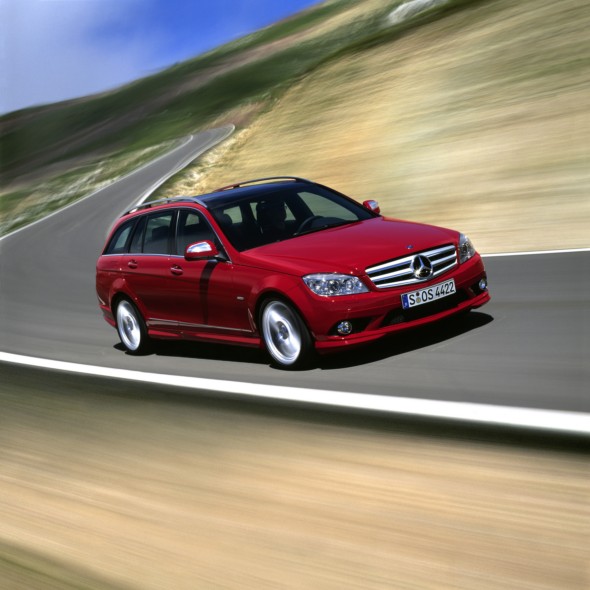
The preventive protection system PRE-SAFE® developed by Mercedes-Benz is available as an option, which makes the C-Class the only car in the world in this market segment to feature such trailblazing safety technology. Another feature providing more driving safety is the Intelligent Light System (optional), which is offered for the first time in this vehicle class.
The Intelligent Light System comprises five different light functions which are configured to typical driving and weather situations and offers the driver a much enhanced visual range.
